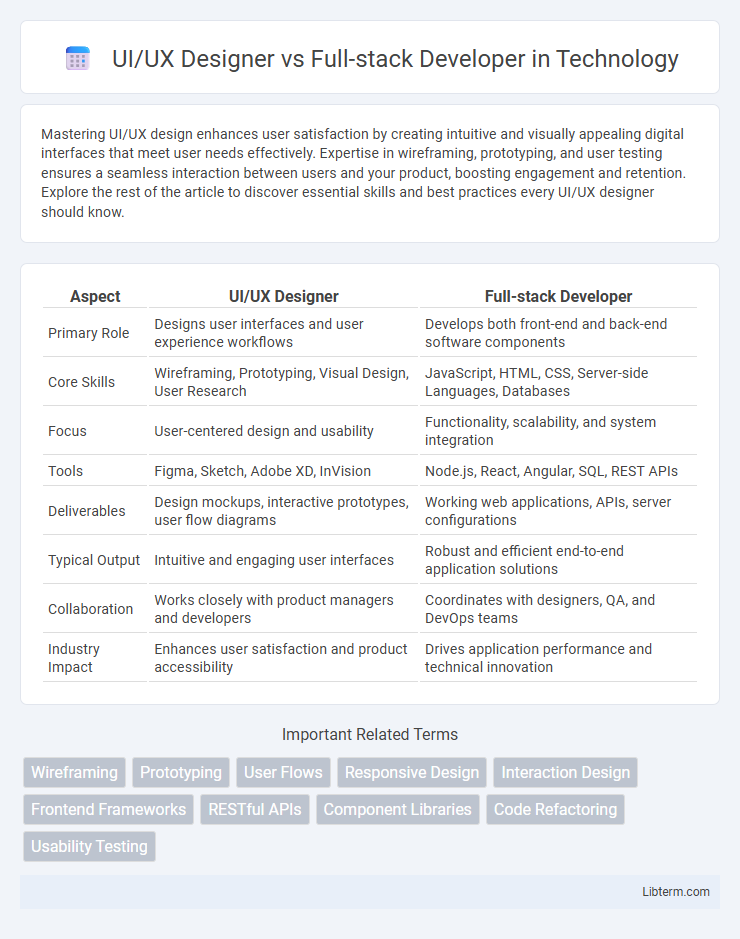Mastering UI/UX design enhances user satisfaction by creating intuitive and visually appealing digital interfaces that meet user needs effectively. Expertise in wireframing, prototyping, and user testing ensures a seamless interaction between users and your product, boosting engagement and retention. Explore the rest of the article to discover essential skills and best practices every UI/UX designer should know.
Table of Comparison
| Aspect | UI/UX Designer | Full-stack Developer |
|---|---|---|
| Primary Role | Designs user interfaces and user experience workflows | Develops both front-end and back-end software components |
| Core Skills | Wireframing, Prototyping, Visual Design, User Research | JavaScript, HTML, CSS, Server-side Languages, Databases |
| Focus | User-centered design and usability | Functionality, scalability, and system integration |
| Tools | Figma, Sketch, Adobe XD, InVision | Node.js, React, Angular, SQL, REST APIs |
| Deliverables | Design mockups, interactive prototypes, user flow diagrams | Working web applications, APIs, server configurations |
| Typical Output | Intuitive and engaging user interfaces | Robust and efficient end-to-end application solutions |
| Collaboration | Works closely with product managers and developers | Coordinates with designers, QA, and DevOps teams |
| Industry Impact | Enhances user satisfaction and product accessibility | Drives application performance and technical innovation |
Understanding the Roles: UI/UX Designer vs Full-Stack Developer
UI/UX Designers specialize in creating intuitive and engaging user interfaces through research, wireframing, prototyping, and user testing to enhance overall user experience. Full-stack Developers handle both front-end and back-end development, managing databases, server logic, and client-side functionality to build complete web applications. Understanding these roles clarifies how UX designers focus on user interaction and visual design, while full-stack developers emphasize coding and system architecture.
Core Skills and Competencies
UI/UX Designers excel in user research, wireframing, prototyping, and visual design tools like Sketch, Figma, and Adobe XD, emphasizing usability, user experience, and interaction design principles. Full-stack Developers possess expertise in front-end technologies such as HTML, CSS, JavaScript frameworks (React, Angular), back-end languages like Node.js, Python, or Ruby, and database management (SQL, NoSQL), enabling them to build and maintain complete web applications. Both roles require problem-solving skills and collaboration, but designers focus on user-centered design while full-stack developers prioritize coding, system architecture, and integration.
Key Responsibilities in Product Development
UI/UX Designers focus on creating intuitive and engaging user interfaces by conducting user research, wireframing, prototyping, and usability testing to ensure a seamless user experience. Full-stack Developers handle both front-end and back-end development, building functional features, integrating databases, and ensuring application performance and security throughout the product development lifecycle. Collaboration between UI/UX Designers and Full-stack Developers is essential to translate design concepts into fully functional, user-friendly products.
Design Thinking vs Technical Implementation
UI/UX Designers specialize in Design Thinking, emphasizing user-centered approaches, empathy mapping, and iterative prototyping to enhance user experience and interface aesthetics. Full-stack Developers focus on Technical Implementation, integrating both front-end and back-end technologies to build functional, scalable applications. The collaboration between Design Thinking and Technical Implementation bridges user needs with practical software solutions, ensuring seamless, efficient product development.
Tools and Technologies Used
UI/UX Designers primarily utilize tools like Sketch, Adobe XD, Figma, and InVision for wireframing, prototyping, and user interface design, emphasizing user-centered design principles and visual aesthetics. Full-stack Developers rely on a diverse technology stack including front-end frameworks such as React, Angular, or Vue.js, alongside back-end technologies like Node.js, Django, or Ruby on Rails, and databases like MySQL, MongoDB, or PostgreSQL to build complete web applications. While UI/UX Designers focus on design and user experience tools, Full-stack Developers integrate programming languages such as JavaScript, Python, and SQL to develop both client-side and server-side functionalities.
Collaboration in Cross-functional Teams
UI/UX Designers and Full-stack Developers collaborate closely in cross-functional teams to create seamless, user-centered digital experiences by combining aesthetic design with robust functionality. Designers provide wireframes, prototypes, and user research insights that guide developers in implementing intuitive interfaces and responsive features. Efficient communication and iterative feedback between these roles enhance product usability, drive innovation, and ensure alignment with business goals.
Career Pathways and Growth Opportunities
UI/UX Designers specialize in user-centric design, enhancing product usability and aesthetics, with career progression often leading to roles such as Lead Designer, UX Researcher, or Design Manager. Full-stack Developers possess expertise in both front-end and back-end technologies, enabling them to build comprehensive web applications, with growth pathways including Software Architect, Engineering Manager, or Technical Lead. Both careers offer strong demand, but UI/UX roles emphasize creativity and user experience, while full-stack development focuses on coding proficiency and system architecture.
Salary Trends and Job Market Demand
UI/UX Designers earn an average salary range from $70,000 to $110,000 annually, with growing demand driven by the emphasis on user-centric digital products. Full-stack Developers command higher salaries, typically between $90,000 and $140,000, reflecting their versatile coding skills and ability to manage both front-end and back-end development. Job market trends show increasing opportunities for Full-stack Developers due to the rise of complex web applications, while UI/UX Designers benefit from growing investment in user experience across industries.
Challenges Unique to Each Role
UI/UX Designers face challenges in creating intuitive user experiences while balancing aesthetics with functionality and accessibility standards. Full-stack Developers confront the complexity of managing both front-end and back-end technologies, ensuring seamless integration, scalability, and robust security measures across multiple frameworks. Each role demands specialized problem-solving skills tailored to either user interaction nuances or comprehensive software architecture.
Choosing the Right Path: Which Career Fits You?
UI/UX Designer and Full-stack Developer careers demand distinct skill sets tailored to different facets of product creation--UI/UX Designers specialize in user experience, interface design, and usability testing, while Full-stack Developers handle front-end and back-end coding, database management, and software architecture. Choosing the right path depends on your passion for visual creativity and human-centered design versus a stronger inclination toward programming, problem-solving, and technical development. Evaluating your strengths and career goals helps determine if you thrive in crafting intuitive interfaces or building comprehensive web applications from server to client.
UI/UX Designer Infographic

 libterm.com
libterm.com